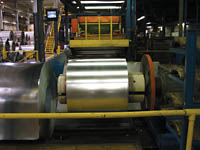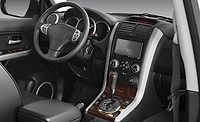Manufacturer Reaps Efficiency Benefits and Cost Savings With Prepainted Metal

By pre-painting metal prior to assembly, a process known as coil coating, manufacturers of products with painted steel, aluminum or other metals will dramatically increase productivity, shrink processing costs, improve quality and reduce environmental concerns - all at the same time.
Just ask Nordyne, Inc., manufacturer of HVAC equipment. Always on the lookout for ways to improve its processes, Nordyne traded in its old internal electrostatic painting process for more efficient coil coating technology.
With this technology, large coils of metal sheet stock (including cold-rolled steel, hot dip galvanized, electro galvanized, zinc-steel, aluminum, stainless steel, copper and brass) can be coated in a continuous, highly automated process prior to fabrication. During this process, the metal is unwound, the top and bottom sides are cleaned, chemically treated, primed, oven-cured, top-coated, oven-cured again, and then rewound for shipment. The variety of coatings available is nearly unlimited, and pre-painted coils are extremely flexible, with the ability to be rewound, drawn, formed, bent and blanked.
Prior to the switch to coil coating, Nordyne had a few concerns. "We were unable to find a coated material that could stand up to the outside elements, especially the salty air on the east and west coasts," reports Dodd Schimpf, plant manager. When they found what they wanted in coil coatings, it revolutionized their systems. Nordyne has since made a 100% switch to coil coating on all of its production lines and subassembly areas.
In making the transition, Nordyne altered its storage and handling methods to avoid scratching the pre-coated parts. They now utilize dedicated storage containers and foam or other material to keep the parts separated and scratch-free. The manufacturer also modified its coating formulations and dies in order to produce deep-draw parts that did not peel, crack or chip. These improvements facilitated Nordyne's move to coil coating and brought significant cost savings, quality and environmental improvements and, most importantly, improved customer relationships and satisfaction. Other improvements due to coil coating include:

Once the conversion process to coil coating was complete, Nordyne ran more efficiently, more effectively and more economically. Coil coating is the ideal solution for any manufacturer looking to lower costs, improve productivity and run a tighter shop. Plant Manager Schimpf summarizes, "For us, this has been a very good transition. It is a tremendous improvement over what we had before, and we have no visions of ever going back."
For more information about this study, or converting to prepainted metal, visit www.coilcoatinginstitute.org, or call the National Coil Coating Association at 216/241.7333.
Looking for a reprint of this article?
From high-res PDFs to custom plaques, order your copy today!





